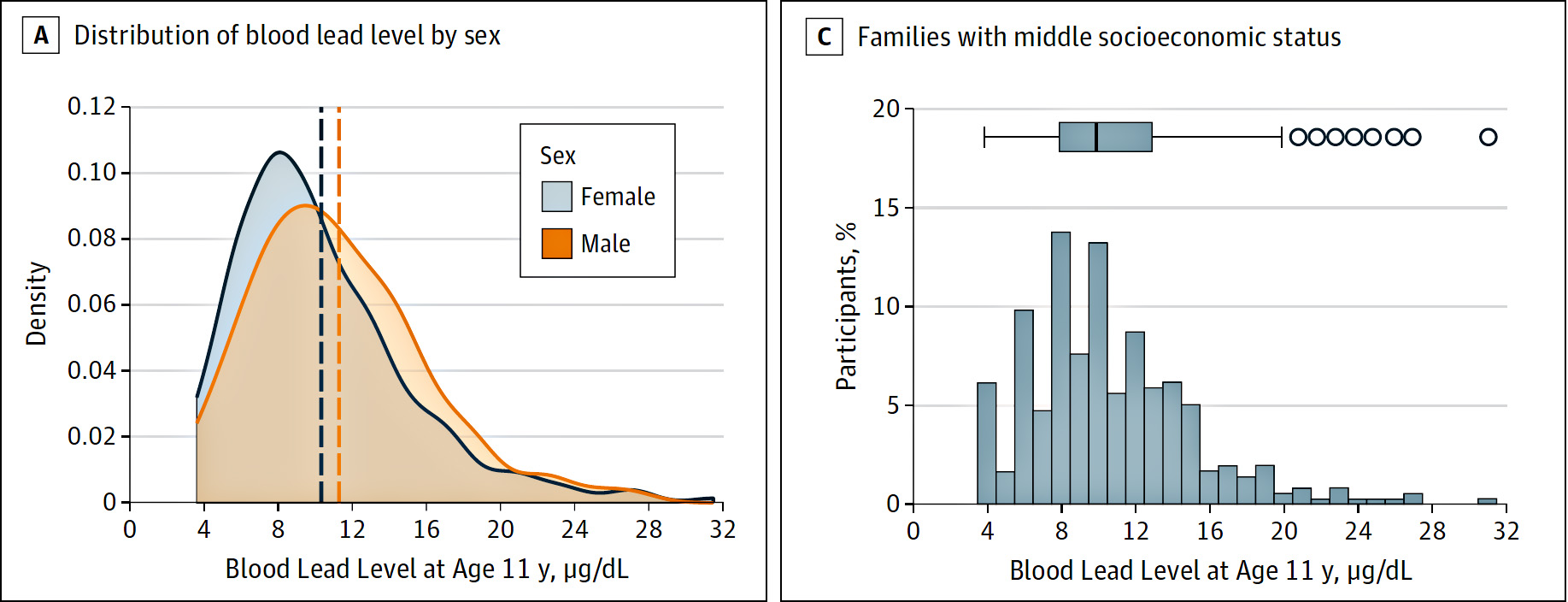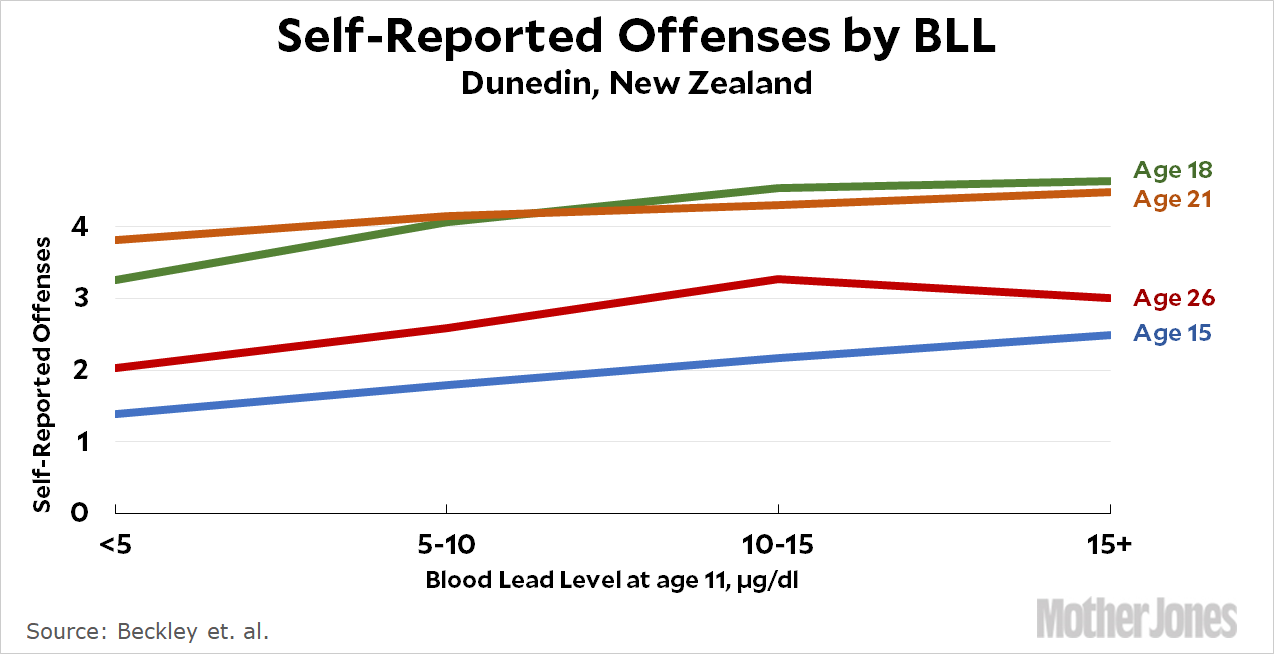Guess what? There’s another lead-crime study out! You can feel the excitement, can’t you?
But this time there’s a twist: it’s a prospective study of data from Dunedin, New Zealand’s fourth-largest city, and the accompanying press release says bluntly, “We found no clear indication that lead was related to crime.” Now, this is not something to get immediately exercised about. Crime has lots of causes and the data is noisy, and there’s no guarantee that every study of every country at every time will produce strong correlations. Unfortunately, that blunt statement in the press release seems to be taking the place of reading and understanding what the study actually says. As it turns out, I think it supports the lead-crime hypothesis fairly well. Unfortunately, as you might expect, it will take me a while to explain. So settle in.
As preface, take a look at the two charts below from Rick Nevin. The black lines show the trend of blood lead levels in young children for both New Zealand and the United States:

The main thing to note is that BLLs peaked at around 15 in New Zealand.¹ By contrast, BLLs were above 15 for nearly 30 years in America, peaking at about 23. This suggests that lead levels were relatively low in New Zealand, and therefore the correlation with crime rates is likely to be weaker than it is here.
However, the importance of this isn’t so much in the average BLLs, but in the tails of the distribution. The most likely future criminals, after all, are the small percentage with the highest BLLs. Here’s the distribution in Dunedin:

This is for a cohort of kids born in 1973. Of the 553 children in the study, 15 percent had BLLs above 15 and about 5 percent were above 20. By comparison, in the late 70s—which is roughly the same birth cohort—the federally-sponsored NHANES study showed that about 65 percent of American preschoolers had BLLs above 15 and 25 percent were above 20. In other words, five times as many American kids had extremely high BLLs as Dunedin kids.² Since most crime is committed by a fairly small number of people at the most antisocial end of the bell curve, this is a critical comparison. And what it says is that crime in Dunedin will be less affected by lead than crime in the United States.
With that out of the way, what do the authors of the Dunedin study find? Their primary analysis compares BLLs with later convictions for criminal offenses. Here’s their conclusion (with some ellipses that I’ll get to later):
Criminal conviction was more prevalent and more frequent at higher BLLs: 8 of 33 participants (24.2%) with a BLL of 5 µg/dl or less had a criminal conviction compared with 24 of 82 participants (29.3%) with a BLL above 15 µg/dl….Logistic regression models supported the positive association between BLL and conviction….Specifically, each 5-µg/dl-higher BLL was significantly associated with a 1.29 increase in the odds of criminal conviction….When comparing offenders who recidivated with nonoffenders, each 5-µg/dl-higher BLL was significantly associated with a 1.28 increase in the odds of being a recidivating offender.
The study also includes data from interviews in which the kids were asked about criminal offenses. Here’s a chart of their basic results:

The children in the study were interviewed at various ages and asked if they committed any offenses in the previous year. For every age from 15-26 (the prime years for crime commission), the kids with higher BLLs reported committing more crimes. In some cases the trendline is fairly steep (age 15) and in others it’s fairly flat (age 21), but it always goes up.
In other words, everything came out the way you’d expect. Both conviction and self-reported crime rose with higher BLLs, and in almost all cases the association was statistically significant. So what’s the problem?
Just this: the authors also chose to report results “adjusted for male sex.” This is unusual, so I asked lead author Amber Beckley about it. “We did this because males tended to have higher average blood lead levels than females,” she told me, which suggests something might be a little skewed with the sample. (You can see the sex difference in one of the charts above.) In any case, when they made this adjustment, the associations weakened slightly and, more importantly, they lost statistical significance at the usual p < 5 percent level. But this says more about the tyranny of p values than it does about lead. In one case, for example, they report a p of 4.6 percent, and that’s statistically significant. In another case, they report a p of exactly 5 percent and that’s not statistically significant. This is correct in a hypertechnical way, but in the real-world there’s little difference between the two. If you report a correlation of lead with crime at the 5 percent level—and they do—there’s really no reason to pretend that the effect has suddenly gone away. For practical purposes, then, here’s what the study concludes:
- Using the unadjusted figures, there’s a clear association of lead levels with both self-reported offenses and criminal convictions later in life. Both are statistically significant.
- Using the adjusted figures, there’s a clear association of lead levels with later criminal convictions, and the association is effectively statistically significant. The size of the association (1.29 increase per 5-µg/dl-higher BLL) isn’t huge, but it’s plenty clear. I don’t think it’s too far off the results of the famous Cincinnati prospective study, especially when you account for Dunedin’s generally lower lead levels and generally higher socioeconomic levels.
- Using the adjusted figures, there’s a clear association of lead levels with self-reported offenses, but the statistical significance is poor.
The only weak result is the third one, and it doesn’t suggest that the lead-crime hypothesis is wrong. In fact, it suggests it’s right. It’s just not very sure of itself. The bottom line, as near as I can tell, is that the Dunedin study mostly supports the lead-crime hypothesis, but at a modest level that’s consistent with New Zealand’s fairly low lead poisoning levels.
Finally, a note about one oddly intriguing finding in the study: the authors find a strong correlation of lead with nonviolent crime but not with violent crime. This is the opposite of what most other studies have found, and it’s a little hard to explain. I suppose it’s possible that small increases in lead produce more property crime but it takes bigger increases to produce more violent crime. That’s just rank speculation, though. Alternatively, given the smallish sample size, it might be nothing more than one of those weird effects you sometimes get. I just don’t know.
Generally speaking, though, I’d say the study provides modest evidence of an association between lead and crime, and that’s about what I’d expect. Despite what the press release says, there’s not much here for me to complain about.
¹As always, blood lead levels are measured in micrograms per deciliter, or µg/dl.
²This is actually a difficult comparison to make. The NHANES study took blood samples of preschoolers, which is the best methodology since that’s the age when kids are most susceptible to lead poisoning. The Dunedin study relies on a single blood sample at age 11, so it’s not clear how high BLLs were at at preschool age. I think it’s safe to say that high BLLs were much more prevalent in America, but whether it’s really 3x or 4x or 5x is a bit of a guess.

















